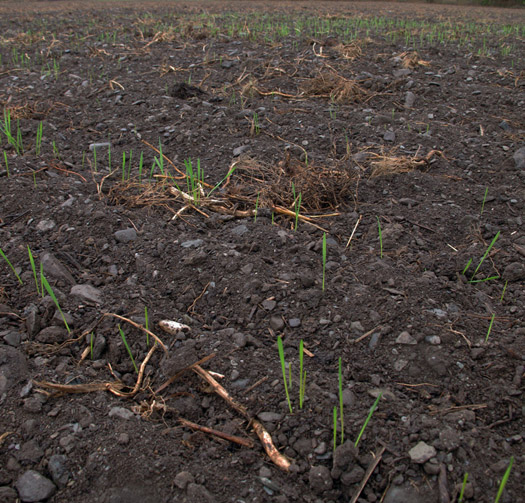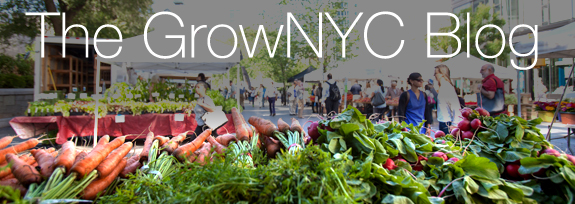The Northeast Grainshed : 2011 Season in Review

Winter wheat coming up at Hawthorne Valley Farm
For farmers in New York and surrounding states, heavy rain was the hallmark of the 2011 season. In many cases, the volume of rain proved disastrous. Grain producers in the Northeast faced a variety of challenges owing to the season’s wet weather, resulting in low yields, poor quality product, and reduced protein content. In Pennsylvania, Fusarium was the biggest culprit. Commonly known as wheat scab or head blight, Fusarium is a fungus, which is found in the ground and infects wheat when rain splashes soil onto plants. Winter wheat is especially susceptible, since it flowers earlier in the season, when rain is more likely. The later growing season in New York this year meant that producers there were largely spared from Fusarium. However, the wet season resulted in a different challenge for these farmers: low protein content. A typical winter wheat grown in the Northeast can have a protein content of around 11%. The 2011 season’s average was below 10%. This may be owing to reduced fertility; heavy rains washed much of the nitrogen that contributes to protein content out of the soil. Given the problems caused by the rainy season, the region’s farmers found a variety of ways to bring their products to the market. Crops infected with Fusarium could, in some instances, sell to outlets like distilleries, which process grains in such a way so that toxins are destroyed. Millers and bakers who could get their hands on high-protein spring wheat blended these with the lower-content winter wheat to create bread flours that met the needs of the region’s bakers. And farmers and millers continue working with bakers to find innovative uses for the diverse grains grown in the northeast. Despite the numerous challenges faced by grain farmers, hopes are high for a better season in 2012. While there isn’t much farmers can do about the weather, planting a greater variety of grains can help hedge against anomalies like excessive rain. For instance, although winter wheat typically produces a higher yield, spring wheat has higher protein content and is more resistant to Fusarium. Increasing the acreage of spring wheat can help balance against issues that make winter varieties more vulnerable. Farmers can also plant more non-wheat grains as a way to diversify. Elizabeth Dyck, founder of the Organic Growers Research and Information-Sharing Network (OGRIN), explains that not a single food-grade grain is being grown in sufficient volume to meet market demand in the New York-Pennsylvania area. For example, there is burgeoning interest in locally-grown rye among the baker community and consumers. Organic brewers and distilleries in the region are seeking out a number of different grains as well. Other farmers and millers point out a similar growth in demand for regional grains. For instance, demand for high-quality bread flour means that hard red spring wheats, which are higher in protein and yield a better bread flour than lower-protein winter wheats, need to see more acres planted in the coming seasons. Emmer is another example of a grain whose supply hasn’t caught up to demand. Currently, the home baker can count on having access to the most diverse array of locally-grown grain products. Outlets like Brooklyn Kitchen carry some local flours and grains, and grain farmers and millers sell their product at several Greenmarket locations citywide. Meanwhile, some producers choose to limit their outreach to larger, wholesale customers until the local supply is sufficient to meet their demand. As the regional grain system continues to develop, organizations like OGRIN can help locate clean sources of seed, work with farmers to order sufficient volume, and give recommendations of good-quality and reliable varieties. Farmers and millers must also continue to find innovative new ways to ensure profitability of grain crops in years where weather jeopardizes quality. As bakers, restaurants, and individual consumers continue to discover regional grains, there will be a need for farmers to continue broadening their offerings to this expanding market. 




Recent Posts
- GrowNYC Publishes 2023 Impact Report
- 2024 Seasonal Greenmarkets and Farmstands Opening!
- GrowNYC's 2024 Plant Sale
- Use Pandemic EBT (P-EBT) with GrowNYC
- The 2024 Health Bucks are now available!
- Sign Our Petition: Save Community Composting
- 2023 Holiday Schedule - Greenmarkets, Farmstands, Food Scrap and Clothing Collections
- Deck the Halls - 2023 Greenmarket Gift Guide & Christmas Trees + Holiday Wreaths at Greenmarkets
- GrowNYC Weather & Site Closures
- Thanksgiving Week Schedule 2023 - Greenmarkets, Farmstands, Compost
Tags
- Grains
- compost
- recycle
- recycling
- greenmarket
- kids
- union square
- swap
- youthmarket
- grow to learn
- learn it grow it eat it
- reuse
Archives
- April 2024 (1)
- March 2024 (2)
- February 2024 (1)
- December 2023 (1)
- November 2023 (3)
- October 2023 (5)
- May 2023 (1)
- April 2023 (2)
- December 2022 (1)
- November 2022 (3)
- September 2022 (1)
- June 2022 (1)
- April 2022 (2)
- March 2022 (2)
- December 2021 (2)
- November 2021 (1)
- October 2021 (3)
- September 2021 (3)
- August 2021 (2)
- June 2021 (3)
- May 2021 (1)
- April 2021 (1)
- March 2021 (1)
- January 2021 (8)
- December 2020 (2)
- October 2020 (3)
- July 2020 (1)
- June 2020 (2)
- March 2020 (6)
- February 2020 (3)
- January 2020 (2)
- December 2019 (2)
- November 2019 (1)
- October 2019 (1)
- September 2019 (7)
- July 2019 (4)
- June 2019 (1)
- May 2019 (1)
- April 2019 (3)
- March 2019 (4)
- February 2019 (3)
- January 2019 (3)
- November 2018 (3)
- October 2018 (3)
- September 2018 (1)
- August 2018 (2)
- July 2018 (4)
- June 2018 (5)
- May 2018 (1)
- April 2018 (1)
- February 2018 (3)
- December 2017 (2)
- November 2017 (3)
- October 2017 (7)
- September 2017 (4)
- August 2017 (3)
- July 2017 (1)
- June 2017 (2)
- May 2017 (4)
- April 2017 (1)
- March 2017 (2)
- February 2017 (2)
- January 2017 (3)
- November 2016 (1)
- August 2016 (1)
- July 2016 (4)
- April 2016 (2)
- March 2016 (4)
- February 2016 (2)
- January 2016 (1)
- December 2015 (4)
- November 2015 (2)
- October 2015 (2)
- September 2015 (4)
- August 2015 (2)
- July 2015 (2)
- June 2015 (3)
- May 2015 (2)
- April 2015 (2)
- March 2015 (1)
- February 2015 (2)
- January 2015 (2)
- December 2014 (3)
- November 2014 (5)
- October 2014 (3)
- September 2014 (3)
- August 2014 (3)
- July 2014 (3)
- June 2014 (2)
- May 2014 (5)
- April 2014 (4)
- March 2014 (2)
- February 2014 (3)
- January 2014 (1)
- December 2013 (4)
- November 2013 (3)
- October 2013 (5)
- September 2013 (4)
- August 2013 (2)
- July 2013 (4)
- June 2013 (2)
- March 2013 (2)
- February 2013 (2)
- January 2013 (2)
- December 2012 (3)
- November 2012 (2)
- October 2012 (3)
- September 2012 (2)
- August 2012 (5)
- July 2012 (4)
- June 2012 (3)
- May 2012 (2)
- April 2012 (4)
- March 2012 (7)
- February 2012 (5)
- January 2012 (9)
- November 2011 (7)
- October 2011 (4)
- September 2011 (2)
- August 2011 (7)
- July 2011 (4)
- June 2011 (2)
- May 2011 (4)
- April 2011 (3)
- March 2011 (5)
- February 2011 (3)
- January 2011 (5)
- December 2010 (5)
- November 2010 (7)
- October 2010 (6)
- August 2010 (1)
- June 2009 (1)
- May 2009 (1)
- March 2009 (1)
- November 2008 (2)
- August 2008 (1)






